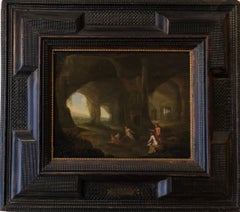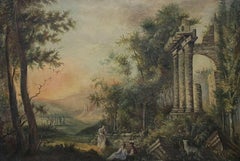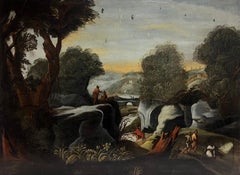Abraham van Cuylenborch Art
1620-1658
Abraham van Cuylenborch was a Dutch Golden Age landscape painter. Cuylenborch enjoyed great success with his pictures amongst contemporary critics and collectors. A preference for imaginary views was the most striking characteristic of Utrecht landscape painting in the 1st half of the 17th century. In other parts of the region, artists concentrated on Dutch landscapes or city vedute. Cuylenborch’s oeuvre consists largely of such grotto. Aside from him, only Dirk Stoop and Carel de Hooch were producing comparable cave pictures in Utrecht. Outside Utrecht, his only competitor was the Amsterdam painter, Rombout van Troyen.
to
1
Overall Width
to
Overall Height
to
1
1
1
1
1
1
1
8,244
2,807
1,643
1,319
1
Artist: Abraham van Cuylenborch
17th Century Classical Oil Painting - Diana With Her Attendants in a Grotto
By Abraham van Cuylenborch
Located in London, GB
Abraham van CUYLENBROCH (1620-1658)
Diana With Her Attendants in a Grotto
1651
signed
oil on panel
12.2 in x 15.7 inches, inc. frame;
31 x 40 cm
Provenance:
Sale of Sotheby's Lo...
Category
17th Century Old Masters Abraham van Cuylenborch Art
Materials
Oil
Related Items
Very Large Antique French Classical Romantic Oil Painting Ancient Ruin Landscape
Located in Cirencester, Gloucestershire
Artist/ School: French School, 19th century
Title: Classical Landscape with figures amongst ancient ruins.
Medium: oil painting on canvas, unframed.
canvas: 24.5 x 36 inches
P...
Category
19th Century Old Masters Abraham van Cuylenborch Art
Materials
Oil
Huge 18th Century Flemish Classical Oil Painting Travellers River Landscape
Located in Cirencester, Gloucestershire
Travellers in Landscape
Flemish Old Master, 18th century
oil on on canvas, unframed
canvas : 29 x 39 inches
Provenance: private collection, France
Condition: very good condition
For...
Category
18th Century Old Masters Abraham van Cuylenborch Art
Materials
Oil
The Road to Emmaus, German Old Master Painting
Located in Stockholm, SE
German School, 1700s
The Road to Emmaus
oil on panel
unframed: 24.3 x 17.5 cm (9.6 x 6.9 inches)
framed: 34.5 x 28 cm (13.6 x 11 inches)
Provenance:
Swedish author and artist Amel...
Category
18th Century Old Masters Abraham van Cuylenborch Art
Materials
Oil, Wood Panel
Shipping in Stormy Waters, Attributed to Italian Artist Francesco Guardi
By Francesco Guardi
Located in Stockholm, SE
The splendour of the tragic sea
Francesco Guardi and maritime painting in Venetian art
No Venetian painter was a stranger to the sea. After all, Venice was not only one of the most prominent ports of the Mediterranean, but indeed a city literally submerged in the ocean from time to time. Curiously however, the famous Venetian school of painting showed little interest in maritime motifs, favouring scenes from the iconic architecture of the city rather than seascapes. That is why this painting is a particularly interesting window into not only the painter Francesco Guardi himself – but to the significance of the element of water in art history, in absence as well as in the centre of attention.
Whether it be calm, sunny days with stunning views of the palaces alongside the canals of Venice or – more rarely – stormy shipwrecking tragedies at sea, water as a unifying element is integral to the works of painter Francesco Guardi (1712–1793). During his lifetime, Venetian art saw many of its greatest triumphs with names like Tiepolo or Canaletto gaining international recognition and firmly establishing Venice as one of the most vibrant artistic communities of Europe. While the city itself already in the 18th century was something of an early tourist spot where aristocrats and high society visited on their grand tour or travels, the artists too contributed to the fame and their work spread the image of Venice as the city of romance and leisure to an international audience, many of whom could never visit in person.
Still today, the iconic image of Venice with its whimsical array of palaces, churches and other historic buildings is much influenced by these artists, many of whom have stood the test of time like very well and remain some of the most beloved in all of art history. It was not primarily subtility, intellectual meanings or moral ideals that the Venetian art tried to capture; instead it was the sheer vibrancy of life and the fast-paced city with crumbling palaces and festive people that made this atmosphere so special. Of course, Venice could count painters in most genres among its residents, from portraiture to religious motifs, history painting and much else. Still, it is the Vedutas and views of the city that seems to have etched itself into our memory more than anything else, not least in the tradition of Canaletto who was perhaps the undisputed master of all Venetian painters.
Born into his profession, Francesco lived and breathed painting all his life. His father, the painter Domenico Guardi (1678–1716) died when Francesco was just a small child, yet both he and his brothers Niccolò and Gian Antonio continued in their fathers’ footsteps. The Guardi family belonged to the nobility and originated from the mountainous area of Trentino, not far from the Alps. The brothers worked together on more challenging commissions and supported each other in the manner typical of family workshops or networks of artists. Their sister Maria Cecilia married no other than the artist Giovanni Battista Tiepolo himself, linking the family to the most renowned Venetian name of the time. During almost a decade, Guardi worked in the studio of Michele Giovanni Marieschi, sometimes simply known as Michiel, a painted similar in both style and motif. Canaletto is, however, the artist Guardi is most often compared to since they shared a mutual fascination for depicting the architecture and cityscape of Venice.
During the course of his career, Guardi tried his hand in many different genres. He was as swift in painting landscapes, Vedutas of Venice, sacred motifs, interiors and architectural compositions as he was in a number of other motifs. His style is typical of the Venetian school but also distinct and personal once we look a little closer. There is an absolute certainty in the composition, the choice of which sometimes feels like that of a carefully calculated photograph – yet it is also very painterly, in the best sense of the word: fluid, bold, sensitive and full of character. The brushwork is rapid, intense, seemingly careless and extraordinarily minute at the same time; fresh and planned in a very enjoyable mixture. His interiors often capture the breath-taking spacious glamour of the palaces and all their exquisite decor. He usually constructed the motif through remarkably simple, almost spontaneous yet intuitively precise strokes and shapes. The result was a festive, high-spirited atmospheric quality, far away from the sterile and exact likeness that other painters fell victim to when trying to copy Canaletto.
The painting here has nothing of the city of Venice in it. On the contrary, we seem to be transported far away into the solitary ocean, with no architecture, nothing to hold on to – only the roaring sea and the dangerous cliffs upon which the ships are just moments away from being crushed upon. It is a maritime composition evoking both Flemish and Italian precursors, in the proud tradition of maritime painting that for centuries formed a crucial part of our visual culture.
This genre of painting is today curiously overlooked, compared to how esteemed and meaningful it was when our relationship to the sea was far more natural than it is today. When both people and goods travelled by water, and many nations and cities – Venice among them – depended entirely on sea fare, the existential connection to the ocean was much more natural and integrated into the imagination. The schools and traditions of maritime art are as manifold as there are countries connected to the sea, and all reflect the need to process the dangers and wonders of the ocean.
It could symbolize opportunity, the exciting prospects of a new countries and adventures, prospering trade, beautiful scenery as well as war and tragedy, loss of life, danger and doom. To say that water is ambivalent in nature is an understatement, and these many layers were something that artists explored in the most wondrous ways. Perhaps it takes a bit more time for the modern eye to identify the different nuances and qualities of historic maritime paintings, they may on first impression seem hard to differentiate from each other. But when allowing these motifs to unfold and tell stories of the sea in both fiction and reality – or somewhere in between – we are awarded with an understanding of how the oceans truly built our world.
In Guardi’s interpretation, we see an almost theatrically arranged shipwrecking scene. No less than five ships are depicted right in the moment of utter disaster. Caught in a violent storm, the waves have driven them to a shore of sharp cliffs and if not swallowed by the waves, crushing against the cliffs seems to be the only outcome. The large wooden ships are impressively decorated with elaborate sculpture, and in fact relics already during Guardi’s lifetime. They are in fact typical of Dutch and Flemish 17th century ships, giving us a clue to where he got the inspiration from. Guardi must have seen examples of Flemish maritime art, that made him curious about these particular motifs. One is reminded of Flemish painters like Willem van de Velde and Ludolf Backhuysen, and this very painting has indeed been mistakenly attributed to Matthieu van Plattenberg...
Category
18th Century Old Masters Abraham van Cuylenborch Art
Materials
Canvas, Oil
$47,804 Sale Price
32% Off
H 25.79 in W 29.14 in
Landscape Near Felday, Surrey
By Abraham Hulk the Younger
Located in Hillsborough, NC
Dutch/English artist Abraham Hulk the Younger (1851-1922) is most known for landscapes of the British countryside. This work is one of a pair (the second work is also available by s...
Category
Late 19th Century Old Masters Abraham van Cuylenborch Art
Materials
Canvas, Oil
$2,240 Sale Price
20% Off
H 27 in W 22.75 in D 2.13 in
Landscape With Pan and Syrinx, Flemish School From the 1600s, Oil on Copper
Located in Stockholm, SE
Flemish School, 1600s
Landscape With Pan and Syrinx
painted around the 1600s
oil on copper
19 x 23.5 cm
frame 29 x 34 cm
Hand-made oak frame by Swedish frame maker Christer Björkma...
Category
17th Century Old Masters Abraham van Cuylenborch Art
Materials
Copper
$5,391
H 11.42 in W 13.39 in
Old master painting of Cherubs cavorting in a woodland setting
By Jean-Honoré Fragonard
Located in Harkstead, GB
A charming image of cherubs cavorting with sheaths of wheat in a woodland setting.
Follower of Jean-Honoré Fragonard
Cherubs cavorting before a tree
Oil on panel
10¾ x 14 inches exc...
Category
Early 19th Century Old Masters Abraham van Cuylenborch Art
Materials
Oil, Wood Panel
Huge 18th Century Classical Italianate Arcadian Landscape Figures & Buildings
Located in Cirencester, Gloucestershire
Figures in an Arcadian Landscape
Italian School, 18th century
follower of Claude Lorrain (French 1600-1682)
oil painting on canvas: 28 x 36 inches
framed: 39.5 by 47 inches
presented...
Category
18th Century Old Masters Abraham van Cuylenborch Art
Materials
Canvas, Oil
$8,760 Sale Price
30% Off
H 39.5 in W 47 in D 2 in
Landscape with Gentleman on Horseback and Peasant Woman Receiving Alms
By Philips Wouwerman
Located in Stockholm, SE
Workshop / Circle of Philips Wouwerman (1619-1668)
Landscape with Gentleman on Horseback and Peasant Woman Receiving Alms
oil on oak panel
12.40 x 14.17 inches (31.5 x 36 cm)
wit...
Category
17th Century Old Masters Abraham van Cuylenborch Art
Materials
Oak, Oil, Wood Panel
$17,907
H 12.41 in W 14.18 in
Stag Hunting in the Vicinity of Nuremberg by a German Artist Peter von Bemmel
Located in PARIS, FR
This small landscape shows a hunting scene: two riders are chasing a stag with their dogs at the edge of a forest. Signed by Peter von Bemmel, it is typical of the production of this...
Category
1720s Old Masters Abraham van Cuylenborch Art
Materials
Copper
17th century Italian school, The Virgin and Child with Saint John the Baptist
Located in PARIS, FR
17th century Italian School
The Virgin and Child with Saint John the Baptist
Oil on canvas
Dimensions: h. 106 cm, l. 77 cm
Important 17th century Italian carved giltwood frame
Fram...
Category
17th Century Old Masters Abraham van Cuylenborch Art
Materials
Canvas, Oil
$25,519
H 53.54 in W 42.13 in
Old Master Painting, Flemish School from 1600s, Saint Nicholas of Tolentino
Located in Stockholm, SE
This small Flemish painting, measuring only 24.5 x 18.5 cm and executed on a copper plate, depicts Saint Nicholas of Tolentino. Created in the 17th century, the artist remains unknow...
Category
17th Century Old Masters Abraham van Cuylenborch Art
Materials
Copper
$4,043 Sale Price
25% Off
H 9.65 in W 7.29 in
Abraham Van Cuylenborch art for sale on 1stDibs.
Find a wide variety of authentic Abraham van Cuylenborch art available for sale on 1stDibs. You can also browse by medium to find art by Abraham van Cuylenborch in oil paint, paint and more. Much of the original work by this artist or collective was created during the 18th century and earlier and is mostly associated with the Old Masters style. Not every interior allows for large Abraham van Cuylenborch art, so small editions measuring 16 inches across are available. Customers who are interested in this artist might also find the work of Flemish School, 17th Century, Jean-Baptiste Monnoyer, and George Morland. Abraham van Cuylenborch art prices can differ depending upon medium, time period and other attributes. On 1stDibs, the price for these items starts at $7,417 and tops out at $7,417, while the average work can sell for $7,417.


